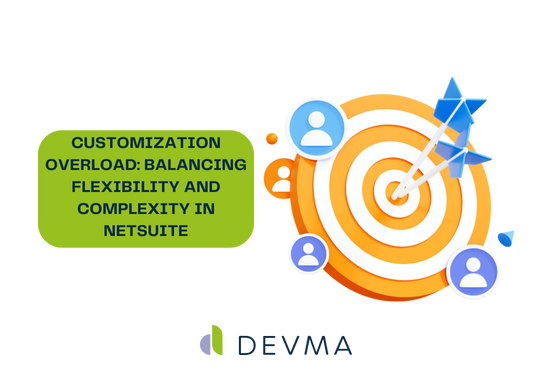Last update: Nov 19, 2024
Customization Overload: Balancing Flexibility and Complexity in NetSuite

NetSuite’s extensive customization capabilities are a major advantage—almost anything is possible if you know how to wield it. Whether you’re adding on custom fields, developing scripts, or building entirely new modules, organizations have the tools to make NetSuite to fit like a glove. Customization not only streamlines workflows and automates repetitive tasks, reducing manual errors, but it also improves user happiness with personalized dashboards and reports that provide quick access to critical data. This customization can also give your businesses a competitive edge by honing in on processes and features that make them unique, and building around them.
The Risk of Over-Customization
But don’t get too excited—while the benefits of customization are clear, it’s easy to go overboard. Customization overload happens when your system becomes too complex, making it difficult to manage and maintain. This can lead to a range of issues:
- Increased Maintenance Costs: More custom features mean more time and resources spent on maintaining and updating the system. NetSuite gets updated regularly, meaning you’ll have to sift through all your custom features regularly as well.
- User Confusion: When a system’s been Frankensteined beyond recognition, users can end up lost and confused, leading to decreased productivity and increased frustration.
- Integration Challenges: Highly customized systems can complicate integrations with other software, potentially leading to data silos and inefficiencies.
- System Performance Issues: Excessive customization can slow down system performance, making it harder for users to access the information they need quickly.
Striking the Right Balance
To maximize the benefits of NetSuite without falling into the trap of over-customization, it’s important to strike the right balance between flexibility and complexity. Here’s how to do it:
- Start with the Basics: Before you think about customizations, make sure you fully understand what NetSuite can do out of the box. You might be surprised at how little you need to tweak to get it working for you.
- Prioritize Customizations: Focus on customizing areas that will have the biggest impact on your business operations. Ask yourself if a customization will significantly improve efficiency, user experience, or competitive advantage. If not, it might be better to stick with standard features.
- Consider the Long-Term: Think about how customizations will affect your system in the long run. Will they complicate future updates? Are they scalable as your business grows? Prioritize solutions that won’t come back to bite you later and are easy to maintain over time.
- Document Everything: Keep documentation of any customizations you make. This will help with system maintenance, especially when onboarding new team members or working with external consultants.
- Test and Iterate: Never roll out a major customization without thoroughly testing it in a sandbox environment beforehand. New customizations often introduce new problems. Be prepared to iterate and refine your customizations based on user feedback and performance data.
Customization with Purpose
NetSuite’s flexibility is one of its greatest strengths, no doubt, but it’s essential to approach customization with a clear strategy. By focusing on the customizations that truly add value and keeping an eye on long-term sustainability, you can avoid the pitfalls of customization overload. The goal is to create a NetSuite environment that works for you as your company evolves, not against you. Balancing flexibility and complexity is the key to getting the most out of NetSuite without slowing yourself down.